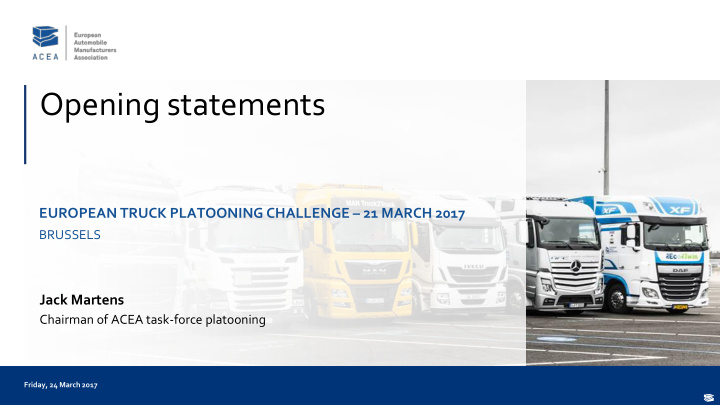



Opening statements EUROPEAN TRUCK PLATOONING CHALLENGE – 21 MARCH 2017 BRUSSELS Jack Martens Chairman of ACEA task-force platooning Friday, 24 March 2017
WHY WE TALK �TRUCK PLATOONING� • Efficient transport is the backbone of EU’s growth and competitiveness, and acts as the link between all other sectors • Demand for transport is increasing, whilst at the same time road networks are not infinitely expandable; it is about using our infrastructure more efficiently • With forward-thinking investments in intelligent transport systems (ITS) however, road transport can be made safer, cleaner and more efficient in the future 2
PLATOONING TOPS TRUCK MANUFACTURERS’ AGENDA • Clean: lower fuel consumption, as the trucks drive closer together; the air drag friction is therefore reduced significantly. • Safe: braking is automatic and immediate in following trucks with just about 1/5 in reaction time compared to human, with no risk for driver distraction. • Efficient: using roads more effectively, helping deliver goods faster and reducing traffic jams with positive impacts on other road users. Platoons will reduce the risk on shockwave traffic jams and allow for orchestrated road use. • Increased productivity: o Increased driving range under certain conditions o Upgrade of drivers’ jobs with possibility to undertake other tasks, such as administrative work or making calls 3
A LOT HAS BEEN ACHIEVED TILL TODAY • New in-vehicle technologies: o Adaptive Cruise Control o Automated Emergency Braking Systems o Active Lane Keeping • Supported and complemented by EU-funded research projects: o CHAUFFEUR I and II o SARTRE o COMPANION o ROADART o Etc. 4
THIS WAS TRANSLATED INTO CONCRETE ACTION • European truck platooning challenge is one concrete outcome and realisation • This goes along with national initiatives ongoing or to be deployed shortly 5
WHERE DO WE WANT TO GO NOW 1. Allowance to drive cross border multi-brand platoons on EU highways on a normal basis by 2023 – i.e. without specific exemption 2. Driver in a following truck resting 3. Full autonomous truck (starting with driver in the leading truck) 6
* = �Enabling technologies’ availability� stands as an indication that these technologies may be available by that time to su pport the introduction of truck platooning. This is not a commitment from truck manufacturers to introduce on serial production these = assessment technologies at a precise date. 7
WE WANT & NEED TO DO MORE TOGETHER • Build on the Declaration of Amsterdam and concrete learnings from the European Truck Platooning Challenge to implement connected & automated driving • Strengthen and extend cooperation with all concerned stakeholders e.g. infrastructure managers, logistic operators, insurers, registration authorities, etc. • To create enabling regulatory framework at both EU and global levels 8
HOW CAN WE SUPPORT • Identification and review of existing legal and policy framework relevant for platooning • Contribute with technical expertise to streamlining a positive framework, allowing for cross-border truck platooning on a normal basis • Create facts and figures in a joint effort regarding advantages and risks of platooning 9
OUR SHORT-TERM ACTIONS & ITEMS 1. Further develop enabling technologies and its applications, including communication standard for multi-brand platooning 2. How to consider CO2 benefits of platooning in regulations? o 7% to 16% Co2 reduction for following vehicles* o 1% to 8% CO2 reduction for the lead vehicle* 3. Involvement in national initiatives * source = ERTICO study: �ITS4CV� 10
TAKE-AWAYS 1. Platooning is enabler for clean, safe, efficient mobility and tops OEMs’ development efforts 2. ACEA is willing to support policy makers to create necessary, enabling framework, including CO2 benefits of platooning and other incentives 3. It is necessary to adopt an holistic view on this new eco- system including all stakeholders 11
THANK YOU FOR YOUR ATTENTION @ACEA_eu www.acea.be
Recommend
More recommend